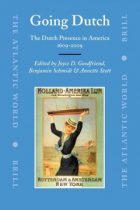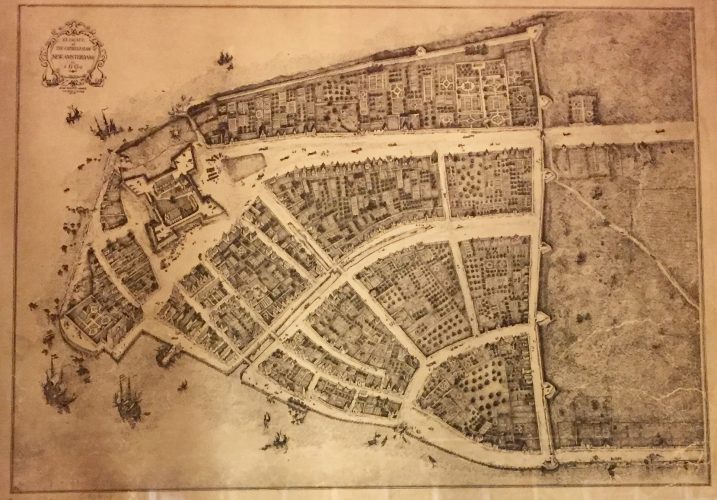Resources to learn about the Dutch’s presence in America as well as their long-lasting influence on the United States.

https://commons.wikimedia.org/wiki/File:Flag_of_the_Mayor_of_New_York_City.svg
Introduction:
While it is easy to assume that United States’ culture stems from its British ancestors, like the Puritans who settled the New England area, the truth behind the United States’ identity is much more complex. The North American landscape, during the colonial period, was a mix of many nations including France, Britain, Spain, and Native America. Although all of these civilizations had an impact on what would become the United States, it may actually be the Dutch and their colony of New Netherlands that had the largest influence. The Dutch settled their colony where present-day Manhattan is before eventually losing it to the British, who renamed it New York. Although the Dutch are often forgotten in regards to their New York presence and their impact on the United States, their influence was real and a general understanding is beneficial for people interested in that time period or academic area.
The Dutch Colony:
Before looking closely at the influence the Dutch had on the United States, it is important to first understand the Dutch colony itself. The following resources are a mixture of images, maps, videos, and articles that all provide information on the Dutch colony. If you are confident in your understanding of the Dutch colony, you may want to move along to the next section, which offers resources on how the Dutch influenced the United States.
The New Netherland Institute is an organization that allows for the continued study of Dutch heritage in America. They offer a short description of the organization on their about us page, writing:
For more than three decades, the New Netherland Institute (NNI) has helped cast light on America’s long-neglected Dutch roots. Created in 1986 as the Friends of the New Netherland Project, it has supported the transcription, translation, and publication of the 17th-century Dutch colonial records held by the New York State Library and State Archives. These records constitute the world’s largest collection of original documentation of the Dutch West India Company and its New World Colonies. They represent an irreplaceable resource for researchers exploring this important chapter in American history, with its legacy of cultural traditions, and its qualities of tolerance, diversity and entrepreneurship. (NNI)
While the organization is a useful resource for academics involved in Dutch heritage, the organization’s website is also a great place for anyone to begin learning about the Dutch and their involvement in America. Amidst the wealth of information offered on the site, three areas may be beneficial for early information. The site offers interactive timelines, which describe various key events in Dutch history. There are also digital exhibitions that showcase Dutch artifacts and maps but also offer an in-depth and interactive tour of the entire Dutch colony. Finally, for more in-depth information, the site has a place to access the many essays and videos they have produced, as well as a schedule of upcoming talks.
Supported by both the New Netherland Institute and the New York State Library, the New Netherland Research Center offers further information and resources on the Dutch. The center provides an excellent, short overview of the colony, as well as some opportunities to dig a bit deeper with links to videos and essays from various sources.
Finally, THIRTEEN has created a special web page highlighting Dutch history. On this webpage – much like the others – there are various resources to help build an understanding of the Dutch colony, including interactive web pages and some excellent videos. One video offered on the site is an hour-long documentary that provides a short overview of the colony. There are a few other short videos worth watching, as they briefly touch on topics that may be of interest, including women, pre-dutch New York, and why the Dutch established a colony. Finally, this video highlights the diversity present in the city, which will help lead into the second section of this topic.
Dutch Influence:
After viewing the video on diversity, and reading through the recurring characteristics of the colony such as multiculturalism, diversity, and religious tolerance, it becomes clear how one might believe that some of the Dutch characteristics have helped to define the United States. Although not considered often, the Dutch hold a key place in defining American culture and values. To pursue this idea, beyond what was already mentioned in the above section, there are two books that are helpful.

- Russell Shorto’s The Island at the Center of the World
“The primary claim of Russell Shorto’s The Island at the Center of the World is that the Dutch colony of Manhattan, by transplanting the religious tolerance, the acceptance of a multi-ethnic population, and the promotion of free trade from its home country, produced a set of values that helped to create the upwardly mobile society that would become New York City and that these values would eventually form the basis of American culture” (From the abstract).

2. Annette Stott’s Going Dutch: The Dutch Presence in America, 1609-2009
“This multidisciplinary collection of essays explores the place of the Dutch in American society and the role of the Dutch in American history and culture over the past four centuries. It also investigates variants of ‘Dutchness’ that developed in America” (From the abstract).


